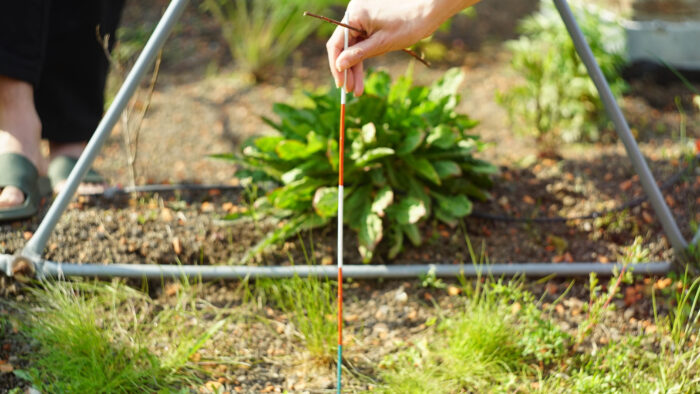Sarah van Lamsweerde, an artist from Belgium likes to experiment with oral traditions and new languages. When she moved to Brussels, she found through Facebook that a friend of hers was taking chanting lessons from Shantala Sriramaiah and decided to take up those classes. It was a nice way to meet new people. She started off with basic Vedic chants and then moved to Devi Suktam and other hymns. It’s been three years since she began learning under Shantala.
For Sarah, chanting has played quite a role in her art. She was originally a dancer and a performer who then shifted her path towards making art, a very emotional process involving personal feelings. She says, “The daily practice of chanting has helped me focus and channel my feelings that are now more in sync with my work.” She is currently learning the Sri Rudram, which has been quite a challenge to master the breath. She says she has a long way to go but has a feeling that the "Rudram has a different kind of power" and will improve her endurance.
Sarah was asked to work on an art project called Farmer in the City and the title made her think of the connect she had with nature. She lives in the city and says that even in big wealthy cities like Brussels and Amsterdam, there are many who have underlying aggressions and are easily provoked. She felt it would be good to not only speak of the positives that happen in life but to also share the frustrations that one bears. It has shown her that art can provide that space for this purpose and this gave rise to the Agripuncture project.

Raoul Carrer in Sore Spot Singing (camera Julie Pfleiderer)
The Agripuncture/ Sore Spot Songs project looks at how humans have controlled the land they live on. In workshops with local participants ‘sore spots’ in the cities were identified and seeds of healing plants were sown in those spaces. During the course of the plantation, the Vedic chant Oshadhi Suktam (hymn to improve the potency of plants) was recited. After that, the ‘sore spot’ stories were transformed into songs created with songwriters and performers Esther Mugambi and Raoul Carrer. Sarah imagined the rituals that happened over 1000 years ago, how chanting helped people connect both physically and emotionally. She said, “Chanting causes vibrations that exist between plants, humans and other animals. Since most chants only use three tones, it was easy for people to chant without having to feel like they cannot sing.”
Chanting and art
Chanting allows one to take a distance from overwhelming experiences and to channel them so they lift you up. Voice and breath connect body and mind as a natural tool to access and balance things in life. “This may be on a microscopic level but even these small moments can inspire people,” Sarah said.
Sarah grew up learning French and Dutch, so articulating the sounds of Sanskrit was not the hardest part of chanting. For her, it was more of a battle with oneself because it makes one feel like being back in school, reliving small traumas of “not doing it right”. It is more about overcoming one’s own judgement.
For now, Sarah and her team will be continuing with the Agripuncture project. They are creating an intervention in the city of Antwerp, a collective effort between Belgian and Congolese artists to talk about decolonisation. They are going to employ chanting and singing to speak about the colonial scars in the city that they consider sore spots Sore Spot Singing Workshop on Vimeo.
Sarah wants come to India, more so to study and also to watch a few rituals like the Agni chayana and other old rituals. She has been to India in 2005 and at the time, she was still working as a dancer. She had some dance colleagues from Amsterdam who had travelled to India to learn the martial art form Kalarippayattu. Being at a point in her career where she wanted to discover other forms of movement, she joined their trainings and decided to travel to India. She and her partner travelled around Karnataka and went down to Kerala for five weeks during when she learnt Kalarippayattu. She had a tough experience and had to learn under difficult circumstances.

Sarah van Lamsweerde in Sore Spot Singing (camera Julie Pfleiderer)
While learning Kalari, she found an interesting connection between the martial art and chanting. The movements were called by the Guru with oral commands called ‘Vaythari’: he would recite the entire sequence and then there would be an unfolding of the movements. He could change the wordings and it would change the movement, similar to the call and response practice in Vedic chanting. At first, she resisted this way of learning without asking questions but later eased in and felt that it was a humbling process.
She said, if not for chanting it would have been difficult for her to channel her personal thoughts into her work. It has definitely helped her to unite instinct and intellect into her art. She extends her deep gratitude to the teachings of Shantala Sriramaiah / www.vedastudies.com.
(Video by Julie Pfleiderer, Agripuncture | Sore Spot Songs is a collaboration between Sarah van Lamsweerde and Esther Mugambi with guest artist Raoul Carrer. The project is hosted and supported by Q-O2, workspace for experimental sound art and Vaartkapoen community arts center, both in Molenbeek, Brussels. The work is kindly cofunded by the City of Brussels and the Dutch Embassy in Belgium. Cover pic: Stick planting: Sore Spot Singing workshop in Brussels, April 2021, photo Anne Reijniers)




